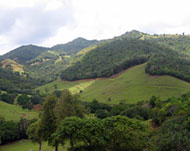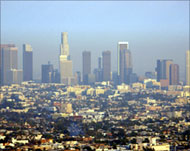Untitled Document
 |
Primary forests are being
lost at the rate of 6m hectares a year |
The world's forests are still being destroyed at an alarming rate despite
a slowing down in the net rate of forest loss because of new planting and natural
growth, a UN agency says.
An average of 7.3 million hectares of forest, an area about the size of Sierra
Leone or Panama, was destroyed annually in the last five years, the Food and
Agriculture Organisation(FAO) said on Monday.
The loss between 1990 and 2000 was 8.9 million hectares a year.
Deforestation was most extensive in South America, where an average of 4.3
million hectares was lost annually over the last five years, followed by Africa
with 4 million hectares, the Rome-based agency said while presenting The Global
Forest Resources Assessment 2005 (FRA 2005).
North America and Oceania saw smaller forest losses over the same period, while
forest areas in Asia and Europe grew, the FAO said.
"While good progress is being made in many places, unfortunately forest
resources are still being lost or degraded at an alarmingly high rate,"
said Hosny El-Lakany, the agency's assistant director-general for forestry.
Changing profile
Forests now cover nearly four billion hectares or 30% of the world's land area.
However 10 countries account for two-thirds of all forest area: Australia, Brazil,
Canada, China, the Democratic Republic of the Congo, India, Indonesia, Peru,
the Russian Federation and the US.
Oceania lost 356,000 hectares a year between 2000-2005, while North and Central
America together lost 333,000 hectares a year during the period.
 |
Forests help offset increasing
industrial carbon emissions
|
Asia moved from a net loss of around 800,000 hectares a year in the 1990s to a
net gain of one million hectares per year between 2000 and 2005, primarily as
a result of large-scale afforestation reported by China.
Forest areas in Europe continued to expand, although at a slower rate than
in the 1990s.
Primary forests with no visible signs of past or present human activities account
for 36% of total forest area, but are being lost or modified at a rate of six
million hectares a year through deforestation or selective logging.
FRA 2005 also found that new forests and trees are being planted at increasing
rates, but plantations still account for less than 5% of forest area, it notes.
Carbon sinks
Forests have multiple functions, including conservation of biological diversity,
soil and water, supplying wood and non-wood products, providing recreation opportunities
and serving as carbon sinks.
While most forests are managed for multiple uses, FRA 2005 found that 11% are
designated principally for the conservation of biological diversity - and such
areas have increased by an estimated 96 million hectares since 1990.
Around 348 million hectares of forests are used to conserve soil and water, control
avalanches and desertification, stabilise sand dunes and protect coastal areas.
One-third of the world's forests are mainly used for production of wood, fibre
and non-wood products, and more than half have production of these products
as one of their management objectives.
Forests are particularly important as carbon sinks: the amount of carbon stored
in forest biomass alone is about 283 gigatonnes (Gt) of carbon, though it decreased
globally by 1.1 Gt annually between 1990 and 2005.
Carbon stored in forest biomass, deadwood, litter and soil together is roughly
50% more than the amount of carbon in the atmosphere.

